Introduction
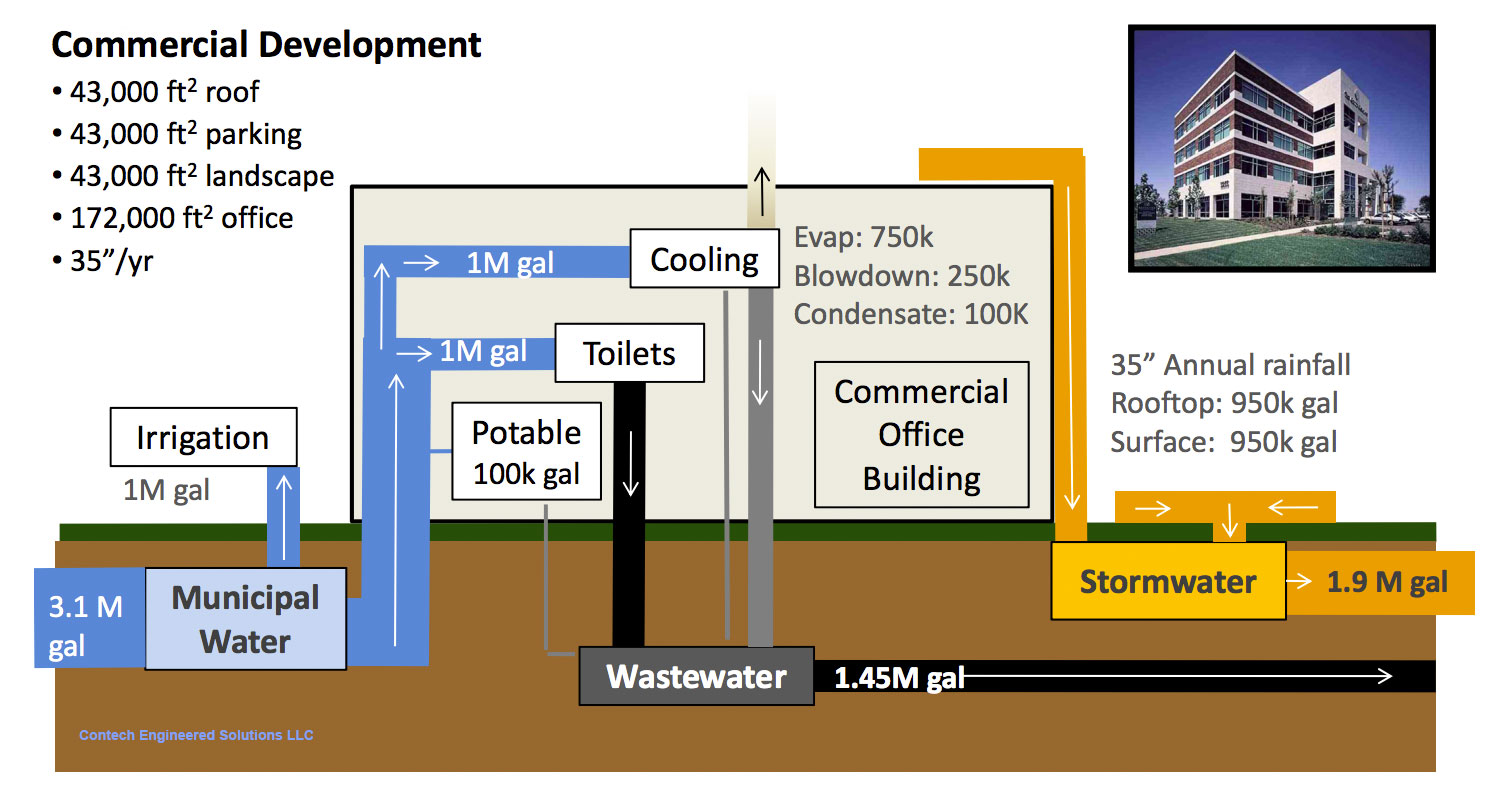
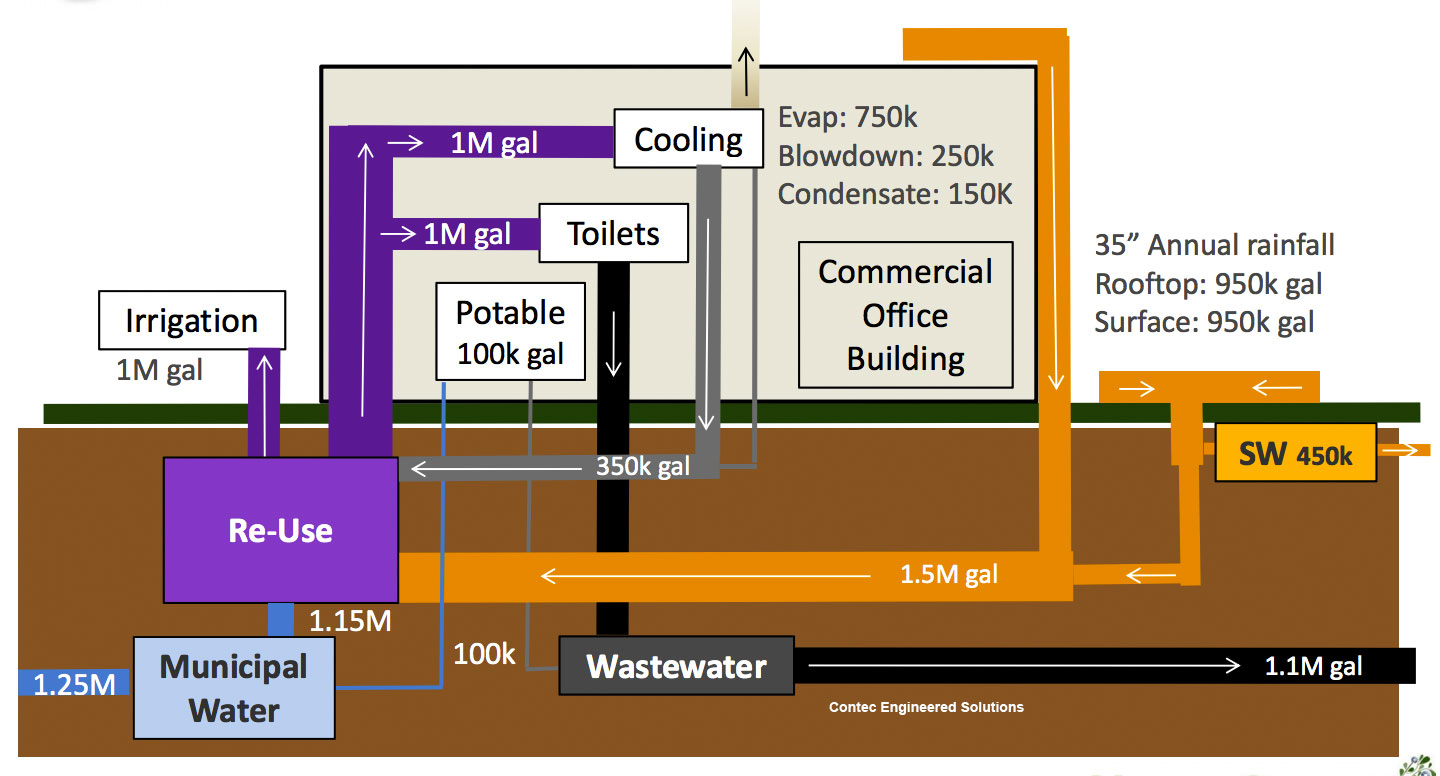
Water harvesting and water conservation potential. Images: Contec Engineering.
There is great water conservation potential from collecting rainwater from the roofs of buildings and reusing it for non-potable uses. The first image above illustrates the water budget of a multistory office building. The roof, parking and landscape areas are about equal at 1 acre. You can see that about 3 million gallons per year is needed to sustain the landscape and building.
The second image shows the benefit of capturing rainfall from the roof and the landscape. The harvested water is used to irrigate the landscape, flush toilets and supply the building cooling system. Note that a significant amount of water can be recovered from the cooling system and reused. The potable water required drops from 3.1 million to 1.25 million gallons. The stormwater runoff decreased from 1.9 million gallons to only .45 million.
Quality of Harvested Water
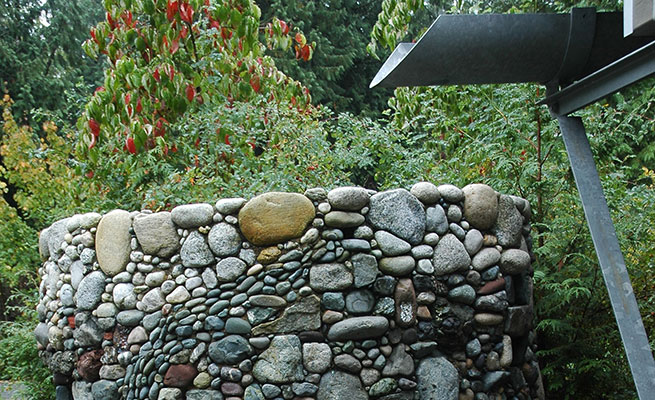
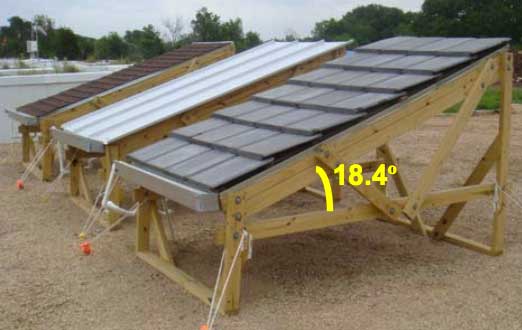
Left: Gutter at IslandWood delivers roof runoff to a stone cistern. Photo: Austin. Right: Experimental runoff water quality test. Photo Mendez, 2010
Water collected from roofs is relatively clean. If fact a study of bacterial pathogens in roof runoff, found that even the first flush (initial 1-2 mm) met drinking water standards (Thomas, 2012). However, another study found that bacteria was above the drinking water standard in the first flush and after the first flush. Pathogenic bacteria can also multiply in the storage tank. An inexpensive and effective method of killing the bacteria is to add 4.3 ounces (125m) of bleach (4% active ingredient) for every 264 gallons (1,000 liters) of water to be decontaminated (Mosley, 2005).
Most of the contaminants in harvested water come from the roofing material and the water holding tanks, but some are acquired by the rain as it falls and collects dust and other pollutants especially at the beginning of the storm. Therefore, harvested water is generally not used for drinking water.
Some roof materials deliver better quality water than others. The best roof type for water harvesting is a metal roof with an enamel finish according to some studies. Asphalt shingles, wood shingles and gravel roofs deliver a substantial amount of contaminants to the collection cistern. Concrete tiles and asphalt/fiberglass shingles have been shown to produce runoff comparable to metal roofing as least when the roofs are relatively new (Mendez, 2010). Lower quality runoff may not be particularly problematic if the water collected is used to flush toilets, irrigate the landscape or other non-potable purposes.
A green roof tested and compared to metal, asphalt/fiberglass and concrete tile roofing consistently had the lowest values of total suspended solids, turbidity, nitrite, aluminum, iron, copper, chromium, total coliform bacteria and fecal coliform bacteria after the first flush. It also had the highest levels of dissolved organic carbon. This reacts with chlorine to form high concentrations of harmful disinfection by-products. Therefore, another disinfection method, such as ozone or ultraviolet light, should be used if runoff from green roofs is to be used as drinking water. Its noteworthy that the green roof also showed the lowest levels of total coliform and fecal coliform bacteria in the runoff. This means that disinfection with ozone and ultraviolet light would be effective. Nitrite and nitrate in the runoff of the tested green roof was also low compared to other roofing materials but this is subject to green roof fertilizing practices. The green roof in the test had a 4" soil depth.
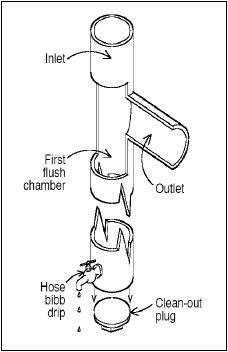
Source: Rainwater Harvesting, Virginia, 2011
Polluted air delivers polluted rainwater to roofs. In the United States this is particularly problematic in the east and upper Midwest where acid rain from coal fired power plants discharge sulfur and nitrogen oxide pollutants. Furthermore, the runoff accumulates contaminants, like pathogenic bacteria, present on the roof. To avoid collecting the most contaminated runoff, the first flush (the first 1 gallon per 100 square feet of roof area) is often discharged to the landscape. The initial runoff is more contaminated but subsequent runoff is not entirely pure. For example, one study found that the levels of turbidity, total coliform bacteria, fecal coliform bacteria, iron, and aluminum exceeded the EPA drinking water standards in the roof (metal, asphalt/fiberglass, concrete tile) runoff after the first flush.
All roofs have greater quantities of unwelcome substances after long dry periods. To avoid these inputs water harvesting systems often employ filters, first flush by-pass and roof wash devices. The image above shows a simple device to discharge the first bit of water collected from a roof.
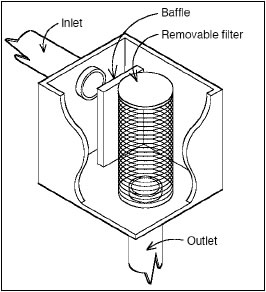
Source: Rainwater Harvesting, Virginia, 2011
The image above shows a similar device but it contains a filter to capture particulates.
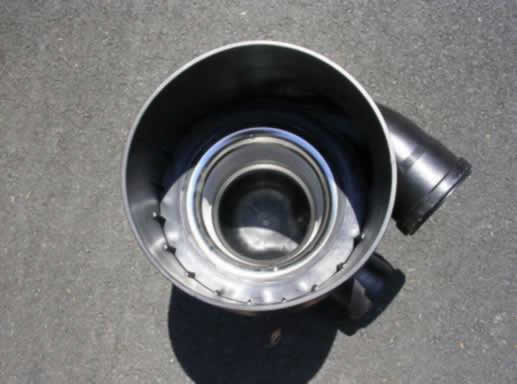
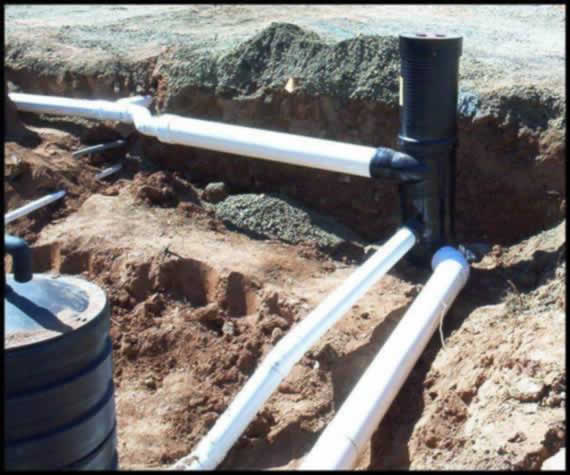
Source: Rainwater Harvesting, Virginia, 2011
The two images above show a filter designed for larger flows. All three of the devices above require periodic maintenance to remove collected sediment and organic matter.
Potential Water Harvesting from Roofs

Potential rainwater harvesting project. Photo: Aaron Luoma.
Not all of the rainwater that falls on a roof can be collected. Some of it escapes through evaporation and especially through any first flush device included in the system. Therefore, we assume that the coefficient of runoff (percent of runoff) is 90. So we will add this to the calculation that we used earlier to estimate the volume collected. Also notice, that in the formula below that there is a conversion of cubic feet to gallons - there are 7.48 gallons per cubic foot of water.
Supply (Gallons) = Catchment Area (Sq. Ft.) x Rainfall (ft.) x Runoff Coefficient x 7.48 gal per cubic foot.
Lets use this formula as it applies to water harvesting in May in Moscow, Idaho. The numbers (inches) below represent precipitation levels of rain and snow in Moscow on average. This information is readily available on the Internet for every city in the country, but in this case the information was extracted from the climate data presented in the previous tutorial. Notice that the formula requires rainfall depth in feet not inches. Therefore, you need to divide inches by 12 to find decimals of a foot.
MOSCOW ; Jan. 3.23; Feb. 2.01; Mar. 1.96; Apr. 1.79; May 1.77; Jun 1.72; Jul. 0.58; Aug. 0.85; Sept. 1.19; Oct. 1.90; Nov. 3.02; Dec. 3.35
The total = 23.37’’
Use the formula above to calculate the gallons of water that can be collected from a 2,000 sq. ft. roof in Moscow in May and with a runoff coefficient of 90%.
Water Demand
Of course, the amount of water that can be harvested is only half of the equation. How much water is needed? We have figures from the previous tutorial to help us estimate non-potable demand within a building. However, harvested water could also be used to irrigate the landscape. A quick way to estimate this demand is to review rainfall, evaporation and transpiration rates. Published Potential Evapotranspiration (PET) Rate tables estimate the amount of water that is needed each month to sustain healthy bluegrass turf. For example, these tables show that about 4" of irrigation must be added in Moscow in July and August to sustain this turf grass.
If a landscape included 2,000' square feet of turf then for these two months we would need 8" (.66 feet) of water or 1,333 (2,000 x .66) cubic feet of water to provide the 8" of water necessary. 1 gallon equals .1336 cubic feet, so there are 7.48 gallons per cubic foot. In our example, 1,333 cubic feet equals 9,970.8 gallons (1,333 x 7.48).
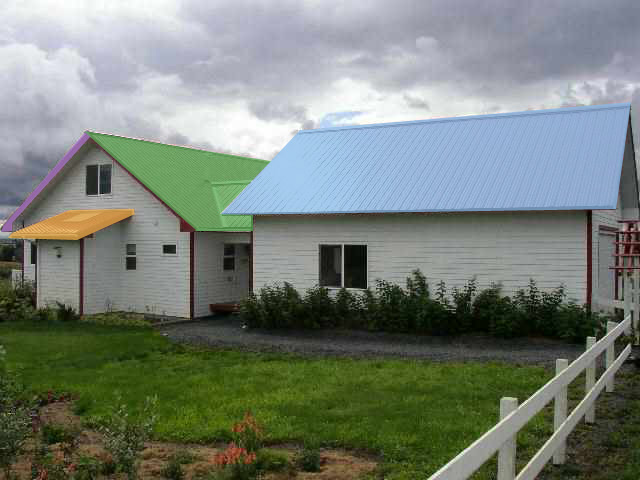
Variation is roof size and orientation, Photo: Aaron Luoma.
The steeply sloping roofs in the image above suggests a number of collection tank locations to serve various areas of the property.
Case Study: Santa Ursula

Laundry
In the small Mexican community of Santa Ursula, a community laundry was built to supply water harvested from the roof. This project was designed by Accion y Desarrolo Ecologica, Daniel Winterbottom, and students of University of Washington. The project consisted of a butterfly shaped galvanized steel roof that collects water and delivers it to a 20' x 10' foot ferro-cement cisterns (ferro-cement is a combination of sand, cement, water and steel in the form of steel wool or hardware cloth). From the cisterns, the water is pumped into a smaller open basin in which the people do laundry. The dirty water is then directed into a grease separator and filtration system then flows into an adjacent orchard for irrigation purposes. The cisterns provide up to one half of the water needed during the dry season. There are plans to enlarge the system so that there will be enough water throughout the dry season. "This project serves as a demonstration model... relieving the natural systems of contamination and providing sustainable amenities to the community" (Winterbottom, 2000).
Case Study: Fife Residence
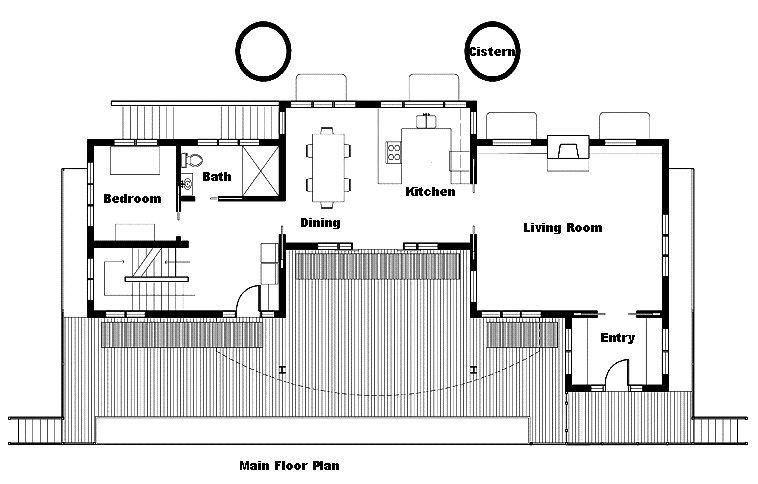
House plan view
Amazing reductions in water use are possible through conservation and water collection and reuse. Ms. Lizette Fife compiled data on the collection and reuse of grey water through experiments her home in Moscow. She demonstrated a 50% reduction in the annual use of water by the residence. This resulted in an annual reduction in potable water use of more than 63,000 gallons by the family of three.
Water collected from the roof of the existing house and garage resulted in about 17,000 gallons annually. This water could be dedicated to irrigation of the the landscape. On-site treatment of grey water and then using it to irrigate the landscape is also a viable process that we will explore in a future tutorial.
Ms. Fife also designed a new home with water conservation features to replace the existing house on their small lot. The plan of the proposed is shown in the images above and below.
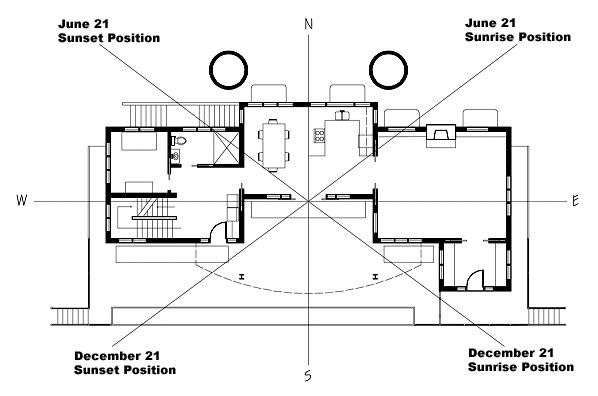
Sunrise and sunset diagram
The proposed design of this residence for greatest sustainability is based on the 12 measures. Those related to water conservation are listed below.
- Install a composting or low flush composting toilet system
- Collect and reuse grey water for irrigation
- Collect and store rainwater
- Landscape with drought tolerant plants
- Specify energy and water efficient appliances for the home
- Compost landscape and kitchen waste and reuse it as mulch.
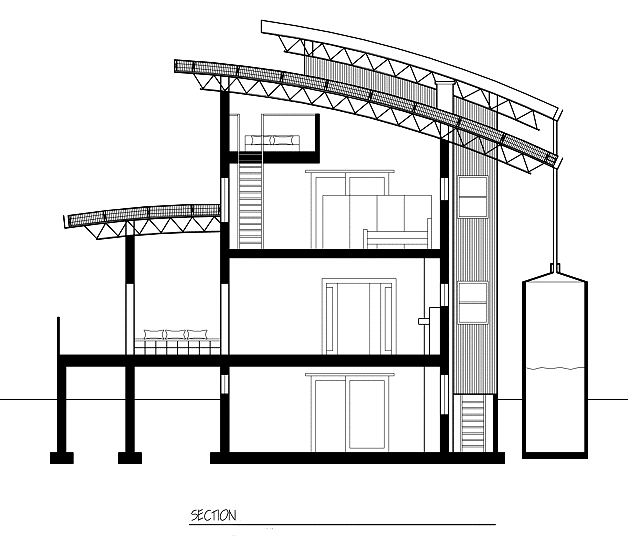
Building section
The cross section illustrates the extent of the roof overhang to shade the windows in the summer and to allow full penetration of sunlight into the rooms in the winter. The rainwater collection cistern, shown on the right, is designed as a visible and attractive architectural element rather than being buried or disguised.
Storage
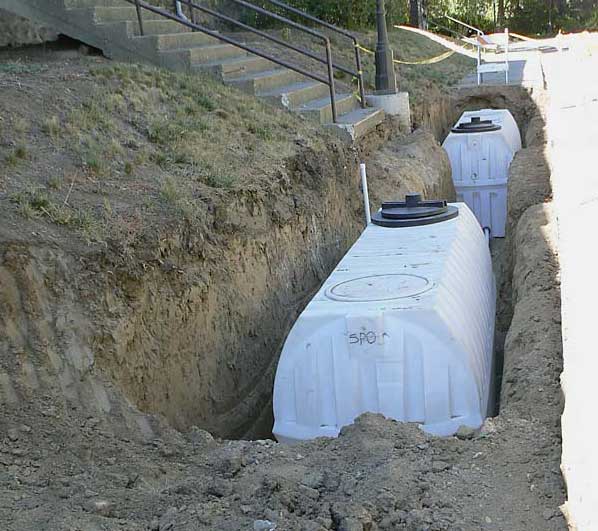
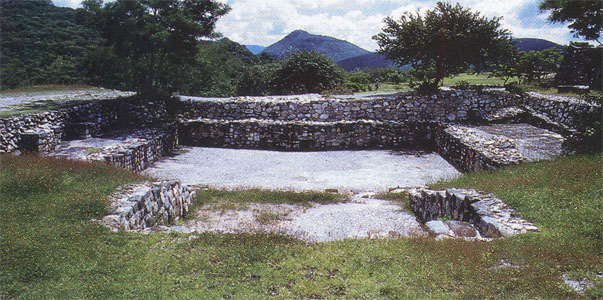
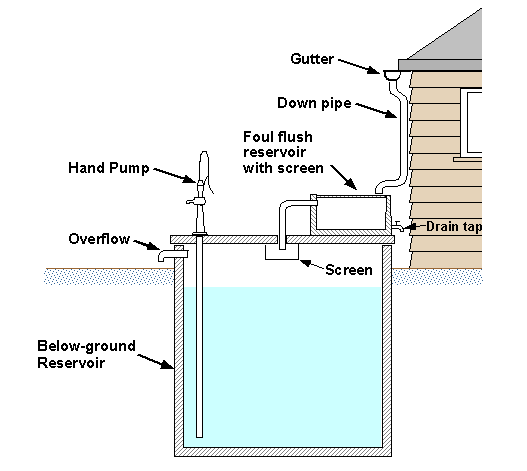
Left: Polyethylene Tanks. Center: Ancient water storage basin. Right: Concrete vault
Harvesting water when it is in excess and storing it for use when it is scarce is generally necessary in the western US where summers are long and dry. Storage can be in above-ground tanks and ponds or below ground in cisterns and pipes. This page illustrates the wide variety of the storage options.
The storage tank is often the most expensive element in the water harvesting system. Storage units come in all shapes, sizes and materials. The most common shape of tank is cylindrical due to the strength to weight ratio (Winterbottom, 2000).
The elements associated with the storage tanks typically include an inlet, an overflow outlet at the maximum water level. A drain is often placed at the bottom of the storage unit so that it can be drained for maintenance, repair, or cleaning.
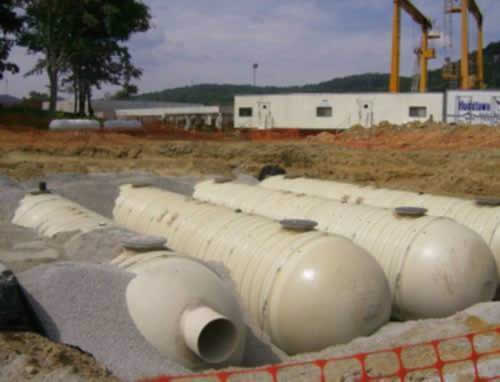
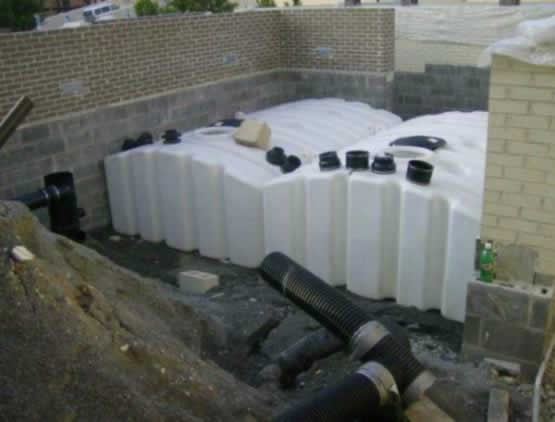
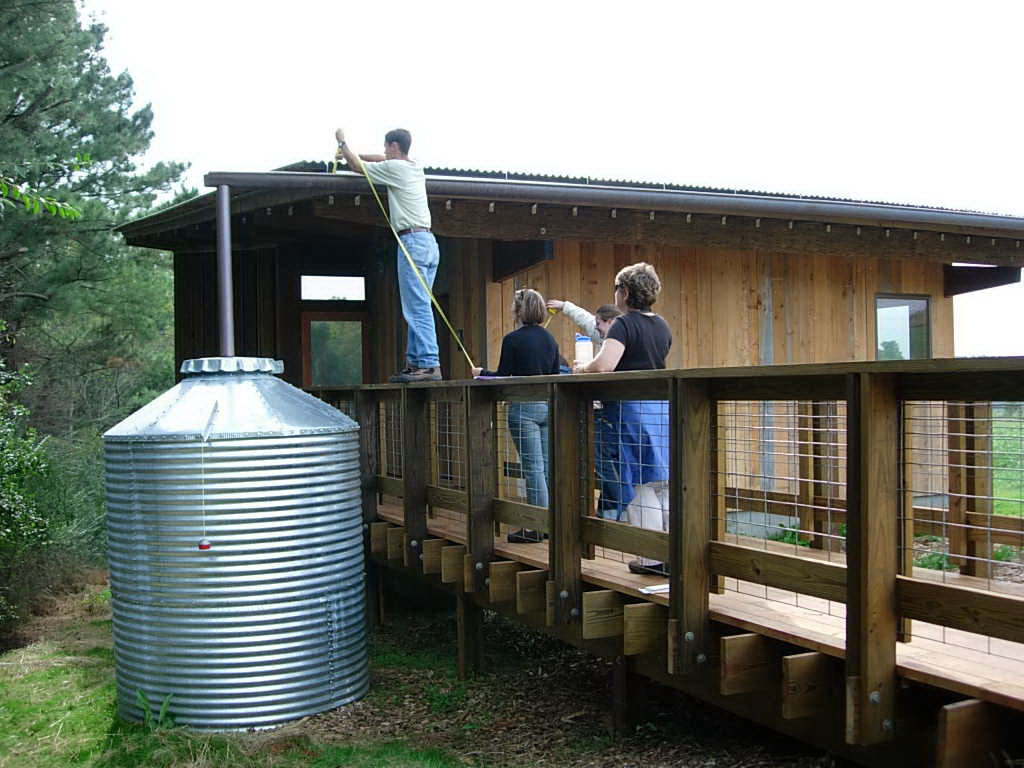
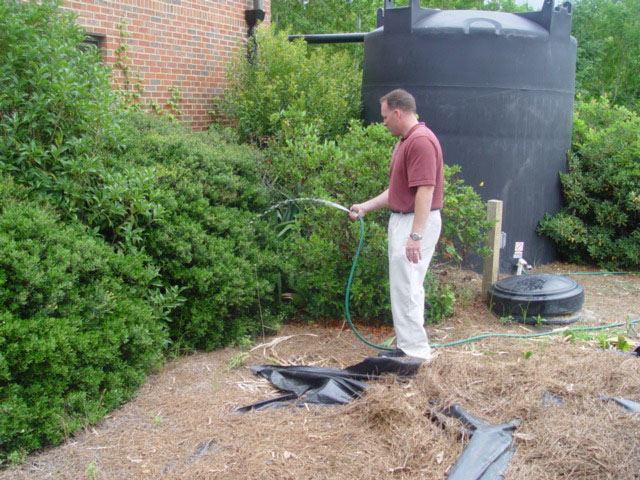
Left: Fiberglass tanks. Center: Polyethylene tanks. Right: Corrugated metal and Plastic tanks Photos: NCSU - BAE
Common materials for storage units are galvanized steel, concrete, ferro-cement, mortared stone, fiberglass, polyethylene tanks, wood stave tanks, and polyethylene liners in excavated holes. Flexible rubber bladders are common in Europe. These pillow-like containers sit on the landscape. Galvanized steel is the most common material used for storage units. When concrete is used, it is often submerged into the ground at least partially.
Ferro-cement is a lower cost concrete container but is labor intensive to construct on-site. Mortared stone storage units are perhaps the oldest of the storage unit types. If designed properly, they can dominate the design and be quite attractive like the IslandWood cistern shown at the beginning of this tutorial.
Fiberglass is probably the least expensive type when a large storage capacity is needed, but possibly the least attractive as well. Polyethylene tanks are light weight and easy to transport but expensive and most suitable for small and moderate application. Polyethylene liners are the lowest cost, but don't last as long as some of the other options (Winterbottom, 2000).
Wood stave tanks, are like wine barrels and should be constructed carefully and without preservatives.
Storage Options
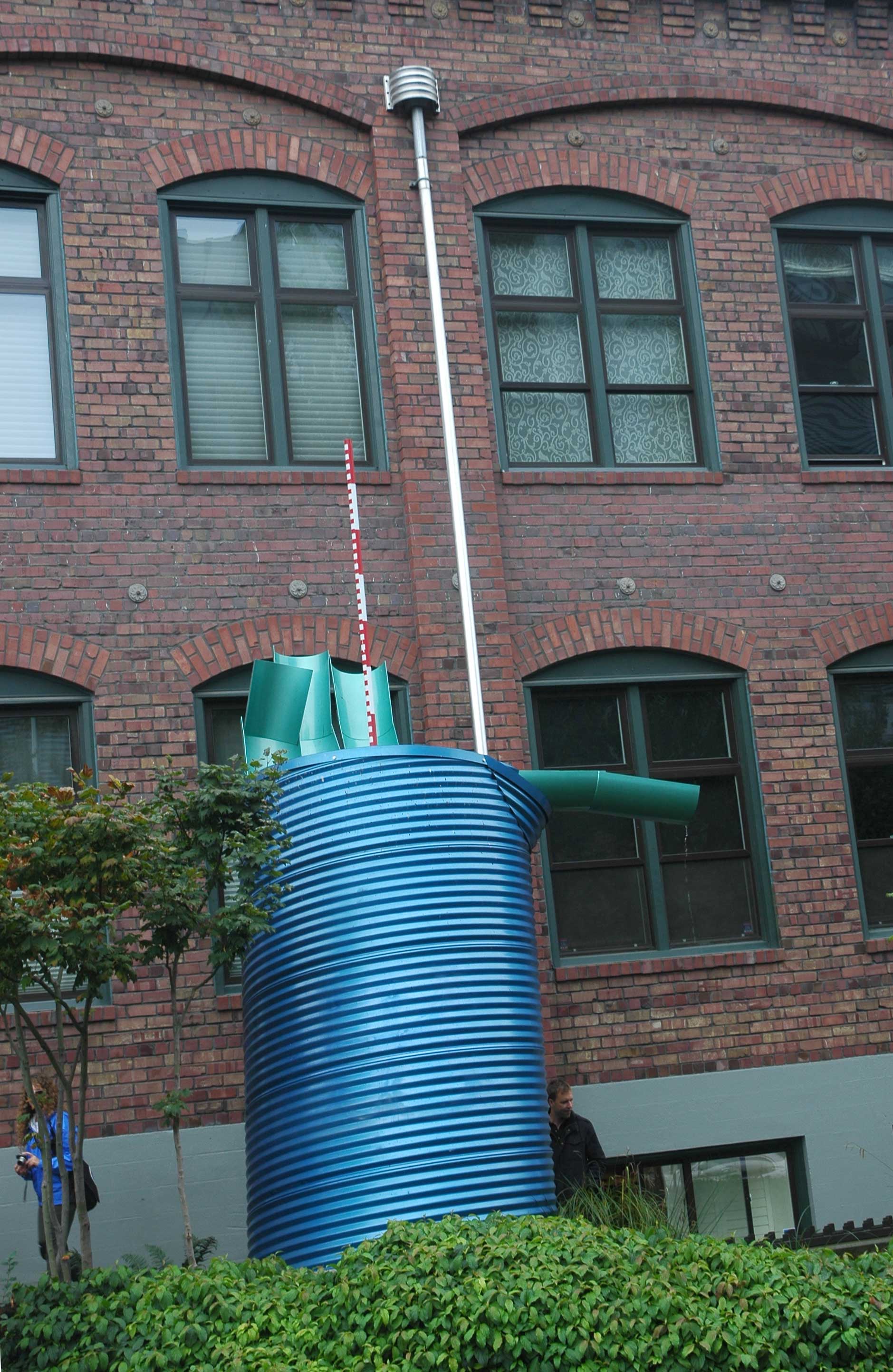
Ornamental tank for harvested rainwater, Seattle. Photo: Austin, 2010.
A major drawback to water harvesting is the appearance of the storage tanks. A good solution is to place the storage tank under a deck, since it is partially hidden and doesn't consume space usable for activities or planting. Small scale wooden cisterns that look like a garden shed are available. Another approach to "hiding" the cisterns is to embrace them as a part of the design. This was successfully done by the students and University of Washington when they designed a water harvesting system for Garden of Eat'in. The cistern used in this project is made of galvanized steel with the dimensions of 13 feet high and a 6 foot diameter. This tank has the capacity to hold 4,500 gallons of water. The overflow outlet was handled as an opportunity to create a unique sculpture that would drain the water to a storm-water system. "The tower has become an unexpected design amenity, serving as an icon for both the park and the west campus (Winterbottom, 2000).
Distribution
We will take up the topic of landscape fine grading and water distribution in some detail in the next tutorial
Study Questions
In the Contec Engineering example of the impact of roof, surface and cooling system capture of non-potable water, what were the effects on potable water requirements and the amount of stormwater runoff?
True/False. Green roofs produce lower quality runoff than metal roofs.
True/False. Rainwater harvested from roofs generally meets EPA drinking water standards even if no disinfection methods are taken.
About how many gallons of water per 100 square feet of roof area represent the first flush?
How many gallons are there in 1 cubic foot of water?
Calculate the gallons of water that can be collected from a 2,000 sq. ft. roof in Moscow in May and with a runoff coefficient of 90%.
True/False. The water harvested for the Santa Ursula project supplied water for both laundry and irrigation.
List the six water conservation features of the proposed home designed by Ms. Lizette Fife.
Draw a section of the residence designed by Lizette Fife. Discuss the design concepts for the building and the site that define this as a sustainable building and site.
References:
Mendez, Carolina B., Afshar, Brigit R., Kinney, Kerry, Barrett, Michael E., Kirisits, Mary Jo. 2010. Effect of Roof Material on Water Quality for Rainwater Harvesting Systems. Texas Water Development Board.
Mosley, Luke. 2005. Water Quality of Rainwater Harvesting Systems. SOPAC Miscellaneous Report 579
Rainwater Harvesting for Drylands by Brad Lancaster, 2009
Thomas, Kyle, E. 2012. Study of Rainwater Harvesting Quality. Clear Waters. Winter 2012.
Waterfall, Patricia. Harvesting Rainwater for Landscape Use, University of Arizona Cooperative, Retrieved from http://ag.arizona.edu/pubs/water/az1052/harvest.html on March 10th, 2005
Winterbottom, Daniel. University of Washington. 2009.